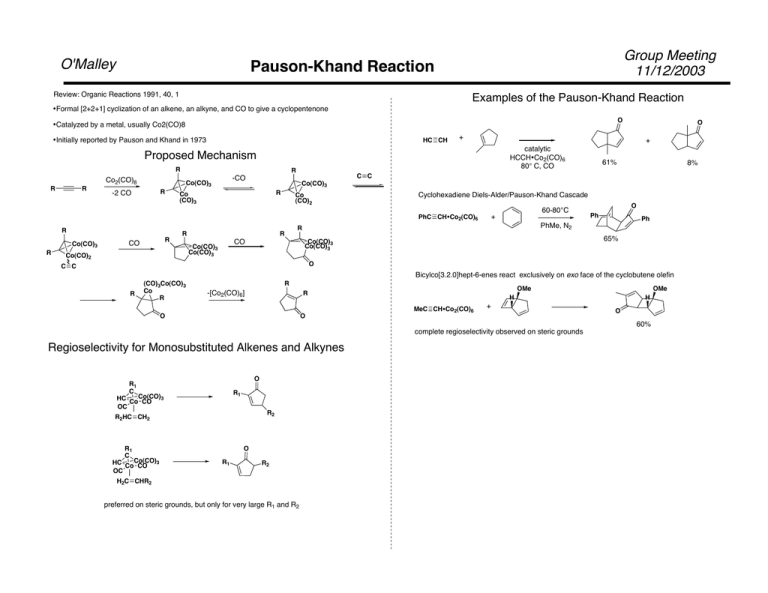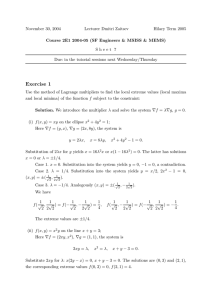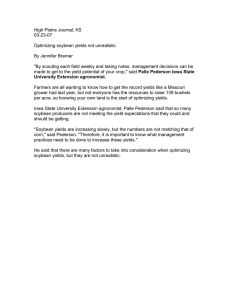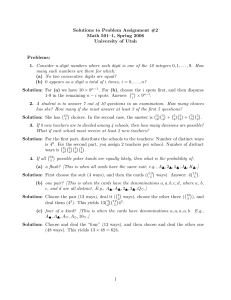Pauson-Khand Reaction Group Meeting O'Malley 11/12/2003
advertisement

O'Malley Group Meeting 11/12/2003 Pauson-Khand Reaction Review: Organic Reactions 1991, 40, 1 Examples of the Pauson-Khand Reaction •Formal [2+2+1] cyclization of an alkene, an alkyne, and CO to give a cyclopentenone O •Catalyzed by a metal, usually Co2(CO)8 •Initially reported by Pauson and Khand in 1973 HC CH + + catalytic HCCH•Co2(CO)6 80° C, CO Proposed Mechanism R Co2(CO)8 R R R R -2 CO Co(CO)3 R R CO R Co (CO)3 R Co (CO)2 R Cyclohexadiene Diels-Alder/Pauson-Khand Cascade Co(CO)2 60-80°C + O Ph Ph PhMe, N2 R 65% Co(CO)3 Co(CO)3 CO Co(CO)3 Co(CO)3 8% Co(CO)3 PhC CH•Co2(CO)6 R 61% C C -CO Co(CO)3 O O C C Bicylco[3.2.0]hept-6-enes react exclusively on exo face of the cyclobutene olefin R (CO)3Co(CO)3 Co R R -[Co2(CO)6] OMe R O O MeC CH•Co2(CO)6 + complete regioselectivity observed on steric grounds Regioselectivity for Monosubstituted Alkenes and Alkynes O R1 C R1 3 HC CoCo(CO) CO OC R2 R2HC CH2 R1 C 3 HC CoCo(CO) CO OC O R1 R2 H2C CHR2 preferred on steric grounds, but only for very large R1 and R2 OMe H H O 60% Group Meeting 11/12/2003 Pauson-Khand Part 2 O'Malley Intramolecular Pauson-Khand Recent Developments •Intramolecular reactions often generate good yields of [3.3.0] and [4.3.0] systems In hept-1-en-6-ynes, C-3 and C-5 substiuents exhibit a strong preference for the exo face of the product •Catalytic reaction using Co nanoparticles on charcoal (Org. Let. 4(22), 2002, 39833986) Good yields for intramolecular reaction, intermolecular reaction using norbornadiene Co2(CO)6 TMS TMS 115° C MOMO(H2C)2 •Asymmetric variant using stoichiometric chiral ligand (JACS, 122(41), 10243) Initial complexation with Co and alkyne gives 1:1-4.5:1 dr Reaction with Alkene after separation of diastereomers gives 70-99% ee and ≥90% yield with norbornadiene O MOMO(H2C)2 H 78% pseudo-1,3-diaxial interaction forces anti-Felkin addition and cis product O TBSO Co2(CO)6 TMS TBSO TMS 115° C S PPH2 BH3 O PuPHOS-BH3 H 79% + 3% of epimeric OTBS •Synthesis of Phenols (OL, 3(22), 2001, 3193-3196, 3197-3200) •Equlibration of propargylic leaving groups can occur 1) 160° 3 days 2) H2 Pd-C H TMS TBSO 1) Co2(CO)8 2) NMO R TBSO TBSO H H R O TBSO 76% single isomer •Allyl propargyl ethers give good yields in solid phase Co(CO)6 90°, Ar 45°, O2 O O SiO2, 30min O 76% O2 scavenges reductive cobalt hydrides R hu 3) R=Alkyl 60-93% R=Aryl 26-50% R=Ph3Si 82% R= R2C(OH) 45-51% H Co2(CO)6 mixture of diasteromers H OH O H O Al2O3, 70 min HO 69% ≥96% Co Mediated Butenolide Synthesis Rh Catalyzed Silylcarbocyclization TL, 31, 5139-5142, 1990; Synlett, 865-866, 1991. JACS. 1992, 114, 6580-6582 O O R1 R2 Group Meeting 11/12/2003 Miscellaneous Oddities O'Malley 1) NaCo(CO)4 R 1 2) HCl + R3 Cl Rh(acac)(CO)2 PhMe2SiH X X=O 85%, X=NAllyl quant. R3 For R1=R2=Et, yields ranged from 56%(R3=neopentyl) to 92% (R3=Pr) For R1=Pr, R2=Me, a 1:1 mixture of regioisomers was obtained R2=Me, R1=Ph or TBS gave >30:1 regioselectivity, but ,50% yield R1=t-Bu, R2=Me, R3=Et gave 91% yield, 20:1 regioselectivity Proposed Mechanism Reaction proceeds viap-allyl lactonyl complex Silylmetalation X X [M] O R1 SiMe2Ph CO 1 atm for X=NAllyl O R2 X Cyclization [M]H X H-shift X SiMe2Ph SiMe2Ph SiMe2Ph O Co(CO)2L R2 Silylation-Double Cyclization R3 Use of a-chloro acyl chlorides gives butadienolides R3Si-[M] O O R1 R2 + R3 NaCo(CO)4 R1 N N O R2 N [M] Cl X [M] CO SiR3 SiR3 R3 For R1=R2=Et, yields ranged from 49%(R3=Ph, X=AcO) to 85%(R3=H, X=PhO) For R1≠R2, regioselectivity ranged from 7:1 to 15:1 SiR3 Rh4(CO)12 65°, CO (1 atm) O N [M] O N [M] 81% 1) -[M]H 2) [M]H addition O (tBuNC)4RhCo(CO)4 65° C, CO (50 atm) H SiR3 O N SiR3 O N [M] SiR3 1)R3SiH 2)-R3Si-[M] SiR3 O SiR3 cyclization O N 3) R3SiH 4) -R3Si-[M] O 62% SiR3 O'Malley Double Cyclization of Cyclohexadiene-Fe(CO)3 Complexes Reaction of polyene- Iron Carbonyl complexes under a CO atmosphere gives tricyclic systems Group Meeting 11/12/2003 Proposed Mechanism Reaction tolerates a wide variety of functional groups Fe coordinates initial alkene, which causes cyclization and elimination to reform Iron carbonyldiene complex. This process is repeated with the seconde alkene to yield the tricyclic system as a single diastereomer. JACS, 2003, 125, 638-639 Group Meeting 11/12/2003 Cascade Cyclization/Coupling of Nickel Enolates O'Malley Multiple Cyclizations •Reaction gives good (50-80%) yields for X=CH2 or O, R1=H or Ph and R2= Alkyl, Aryl, SiR3 •Reaction gives poor yields when R2=H or COCH3 •Mechanistic experiments, including isolation of initial Nickel enolate, were carried out Proposed Mechanism O H Ph Trapping with Electrophiles OH Ph H O H Ph Electrophile E OH Ph H Yields of 68-82% for Alkyl, Allyl, and Benzyl Iodides, Aldehydes, and Acyl Chlorides JACS. 125, 13481-13485, 2003. Reaction of allyl halides with indium metal yields allylindium reagents, which can react with electrophiles These reagents are often generated in the presence of the electrophile Allylindium also reacts witih aryl and tosyl hydrazones and aldonitrones H N Ph or Ts N OMe O Br + MeO In OH Ar MeO H2O, 70% MeO Attack of allylindium reagent occurrs from the g-carbon unless a very bulky (R3Si, or tBu) substituent is in the g-position, or in intramolecular cases O R' Br InBr DMF / H2O R H HN N Ar R Ar 75-90% for R=H,Me, or Ph, fails for aliphatic hydrazones Indium-mediated allylations can be carried out in water and do not require that acidic groups such as hydroxyl be protected R Group Meeting 11/12/2003 Organoindium Reagents O'Malley OH Ph N H O InBr N OH Ar DMF / H2O Ar Ph 75-90% Tet. Lett. 41, 2000, 9311-9314 H Organoindium reagents can be used in carbonylative couplings with aryl and vinyl halides and triflates R R3In + Diasteroselectivity in addition to cyclic substrates is far superior to that of Grignard reagents OH O t-Bu t-Bu allyl allyl allylMgCl allyl2In2Br3/ 4(H3C)CCH2OLi t-Bu OH O CO, Pd(PPh3)4 3 R R' 70-94%for R= Ph, PhCC, Me, or Bu, R'=Aryl or Vinyl, X=Br, I, or OTF Synthesis. 2003, 780-784. Allylindium reagents can be also be used for the syn allylation / halogenation of cyclopropenes In2X2 OAc 45:55 (90%) 90:10 (99%) OAc R NIS (2 equiv), LiCl 3 R H H Synthesis, 2003, 633-655 H CO2CH3 OAc R or NBS (2 equiv), LiCl InX2 R=C6H13 Excellent diastereosselectivity has also been observed in acyclic cases OTBS 3 R'X H X X=I 83% X=Br 82% Halogen is transferred from Indium, use of 1 equiv. NIS gave X=H (86%) OTBS H O H3C CH2Br CO2CH3 If OAc replaced by a directing group, addition is syn OH 95% Synthesis, 2003, 765-774. OH R In2X2 3 H O H R R=C6H13 Tett. Lett. 43, 2002, 8033-8035. OH NIS (2 equiv), LiCl I2In H I R H 41% Group Meeting 11/12/2003 Samarium Diiodide- Radical Cyclizations O'Malley Radical Cyclizations Samarium(II) easily loses an electron to form a stable Samarium (III) species. It is therefore a good stoichiometric radical initiator. SmI2 can also open cyclopropyl ketones O O HO O SmI2, THF, HMPA n SmI2, THF, DMPU CH3 CH3 n n=1 86% >150:1 d.r. n=2 91% 36:1 d.r. n=3 52%1-methylcyclooctanol 39% O O H3C O n SmI2, THF, HMPA SmI2, THF, DMPU HO n 57% CH3 m m yields 85-92% for n and m= 1 or 2 good d.r. except for m=n=2 (2:1:1) reaction fails when n=0 O O H CO2Me Mechanism O O SmI2 O SmI2 CO2Me H CH2 77% O O O SmI2 HO CH3 CH3 SmI2 Resulting samarium grignard can also be trapped by electrophiles CO2Et CO2Et 45% mixture of diastereomers 1)SmI2, THF, HMPA HO O CH3 E 2) Electrophile Yields 65-83% for a wide range of electrophiles, including ketones, aldehydes, anhydrides, CO2, O2, and CH2NMe2+I- JOC. 1992, 57, 3132-3139 The resulting samarium enolate can be trapped with electrophiles OAc O SmI2, THF, DMPU AcCl 57% Other combinations of substrates and electrophiles are possible E I O O Yields of 55-96% for ketones, I2, Bu3SnI, PhNCO, (iPrO)2O. (PhS)2,( PhSe)2 JACS, 1992, 114, 6050-6058 Tet.. Lett., 32, 6649-6652, 1991. Group Meeting 11/12/2003 Samarium Diiodide O'Malley One-Carbon Homologation of Esters to Cyclopropanols SmI2 Initiated Pinacol Couplings Ketyl radidcals generated by SmI2 can undergo intramolecular pinacol coupling OR OR OH + CHO OH 76% optimized yield for X=OEt, low unoptimized yields for X=OiPr, Cl, SBu, NMe2, and OH acid chlorides undergo competitive coupling to diketones and acyloins OH Proposed Mechanism: 84%, 84:16 d.r. This reaction can be used to synthesize carbohydrate-like structures O O Ph OMe CHO CHO O O O Ph Ph OR OH CHO HO CH2I2, Sm, THF PhCOX OMe OH OH O O + O O Ph O OMe OH Ph Ph X CH2I2, Sm OH Sm or 2SmI2 InSmO O CH2I2, Sm InSmO Ph CH2I HO H2O Ph Ph 53%, 83:17 O RO O O CHO CHO Other Substrates: O RO O CH I , Sm, THF 22 OH OH OH O OH 45% 59% Preferred orientation of resulting diol groups is syn and anti to neighboring alkoxy substituents. This implies a 9 membered ring controls diol stereochemistry. R OR Smiii RO O O Tet. Lett. 32, 1125-1128, 1991. C8H17 CO2CH3 C7H14 HO CH2I2, Sm, THF C8H17 C7H14 70% R HO OH Tet. Lett. 30, 5149-5152, 1989. CH2 O'Malley Meeting Synthesis of Quinolizidines, Indolizidines,and Pyrrolizidines Group 11/12/2003 Samarium complexs catalyze the cyclization of dienes and enynes to bicylic structures Formation of Quinolizidines and Indolizidines R1 R1 1)NaOH 2)catalyst n R2 N H R3 3)HCl N R3 •HCl R4 n R2 R4 catalyst= Cp2NdCH(TMS)2, Cp2SmCH(TMS)2, Me2SiCp2NdCH(TMS)2, or [CpTMS2NdCH3]2 Yields were 80-90% for monomethyl compounds, n=1 or 2 d.r. was high for Me at R1 or R2, low for Me at R3 or R4 Stereochemistry of Various Products H H Me H Me Me N Me Me 90% >20:1 d.r. 85% >50:1 d.r. 86% 27:1 d.r. Formationof Indolizidines and Pyrrolizidines R1 R2 R3 Proposed Mechanism n N H 1)NaOH 2)catalyst R1 n N R2 •HCl 3)HCl R3 Yields were 83-91% for monomethyl compounds, n=1 or 2 d.r. was high for R1=Me, n=2, moderate for R3=methyl, n=2, low for others J. Org. Chem. 2003,68, 9214-9220. Group Meeting 11/12/2003 Organometallic Miscellanea, Part I O'Malley Ytterbium mediated umpoled addition of ketones to electrophiles MnIII Promoted Lactonization of Olefins O Yb metal is known to reduce ketones to alcohols O O Yb Ar Ar Ar' OH H2O Yb Ar Ar Ar HO HO Yb Ar' Ar RCOR' Ph O AcOH, D Ar The ytterbo-oxocyclopropane intermediate can be trapped by electrophiles O Mn(OAc)3 60% Ph Reaction Proposedly Proceeds the Generation of an acetate radical anion O R' MnIII O Ar' R Ph O O O Yields are generally >80%, except with acetone small amounts of diaryl alcohol are also formed Ph O Ph Trapping with nitriles gives acyloins after aqueous workup O Ar Ar' Yb HO RCN Ar O O Ar' R O Yields are generally >75%, except with acetonitrile small to moderate amounts of diaryl alcohol is formed This method allows for the generation of complex bi- and tri-cyclic lactones Trapping with epoxides yields 1,3-diols O Ar Yb Ar' Ar OH OH HO R'/H R Ph Ar' R R'/H or cyclohexene oxide Yields were 40-75%, propylene oxide and styrene oxide gave attack at more substituted carbon, isobutylene oxide wa attacked at less substituted position O O O H O AcOH, 20 min H H O 63% O O O OH Mn(OAc)3 H O O AcO Diphenylacetylene and Acetaldehyde were attacked in good yield Phenyl isocyanide and Dimethylformamide gave moderate yields of the hydroxy amide and hydroxy aldehyde, respectively JOC. 1988, 53, 6077-6084. H Mn(OAc)3 H 88% JACS. 1984, 106, 5384-5385 Tungsten-Catalyzed Allylic Alkylations Aluminum promoted Baylis-Hillman Alternative Complexation of DIBAL with NMO prevents reduction of esters and allows hydroalumination iBu2Al CO2Et DIBAL-NMO R Tungsten carbonyl compounds ar e known to form p-allyl complexs with allyl halides CO2Et R R These reagents can be trapped with ketones, a-keto esters, and a-halo ketones O R' R' BF3•OEt2 R WLn R X OH CO2Et R "W" X iBu2Al Group Meeting 11/12/2003 Organometallic Miscellanea, Part II O'Malley CO2Et These complexes undergo attack by nucleophiles in a manner similar to Pd complexs Regioselectivity is reversed however; attack occurs at the most substitued carbon R 70-80% (2 steps) Succeeds with 2-butanone, which fails under Baylis-Hillman Conditions Ph O iBu2Al R'' or OR'' CO2Et R' R' OH R''O ro "R CO2Et O O R OCO2Me (CH3CN)3W(CO)3 bpy 75-95% R 2 R' R JACS, 115, 1983, 7757-7759. R 50-60% for R=H J. Org. Chem. 2003, 68, 9310-9316 CO2Me CO2Me 91 % A large variety of aryl substituted allyl halides were tested, yields were mainly >80% in most cases >95% regioselectivity was observed Reaction witha-halo ketones, followed by base gives epoxides 1) O R' O iBu2Al CO2Et Br CO Et 2) K2CO3, or KF MeO2C Na MeO2C Ph Group Meeting 11/12/2003 Organometallic Miscellanea, Part III O'Malley Gold Catalyzed Furan Formation Insertion of Homoallylic Alkoxides Into Tantalum-Alkyne Complexes Although some stoichiometric gold reactions are known, there are surprisingly few Gold-catalyzed reactions Tantalum-alkyne complexes can be generated from TaCl5 and alkynes AuCl3 catalyzes the formation of furans from keto allenes or keto alkynes R TaCL5, Zn R R Ln R C Ta R Cl Ln C5H11 C5H11 OLi Ta Ln-1 Cl C5H11 O C5H11 C5H11 O O Et Et O C5H11 O 0.1% AuCl3 O Et Multiple Cyclizations are possible O 1% AuCl3 HO C5H11 86% Ta Cl JOC, 59, 1994, 5852-5853 O OH BuLi, then Ln O O OH A phenol was also tested C5H11 Et < 1hr quantitaive Multiple olefins were tested: substitution on the double bond lowered yields dramatically, but substitution elsewhere gave yields 70-80% Addition of a third methylene between the alkene and alkoxide had little or no effect on yields C5H11 O 46-74% C5H11 80% from alkyne, 98%v regioselectivity C5H11 R' R'' H2O Ln R 1% AuCl3 R=aryl or sugar, R'=Me or Et, R''=H or me Ta HO HO R' O Normal alkenes fail to insert into these complexes, but do when a directing group is present to coordinate to the Tantalum C5H11 R'' + Angew. Chem. Int. Ed. 2002, 39, 2285-2288 61% Group Meeting 11/12/2003 Organometallic Miscellanea, Part IV O'Malley Thulium Coupling of Alkyl Halides Lanathanide Nitrate Nitration of Phenols Thulium Diiodide acts in a similar manner to SmI2, but is more powerful Lanthanide Nitrates are known to nitrate phenols OH R OH X M(NO3)3 R OH TmI2O O2N tBu R 99%, 77% axial OH M=La, Ce, Sm, Dy, Ho tBu Yields ranged from 60-85% R groups included NO2, Me, Cl, OH, NHCOCH3, CO2H, OMe Syn. Comm. 27, 2793-2797, 1997 Yields were > 97% for RX where R= Me, Bu and X=Cl, Br, or I JACS. 2002, 122, 2118-2119.





